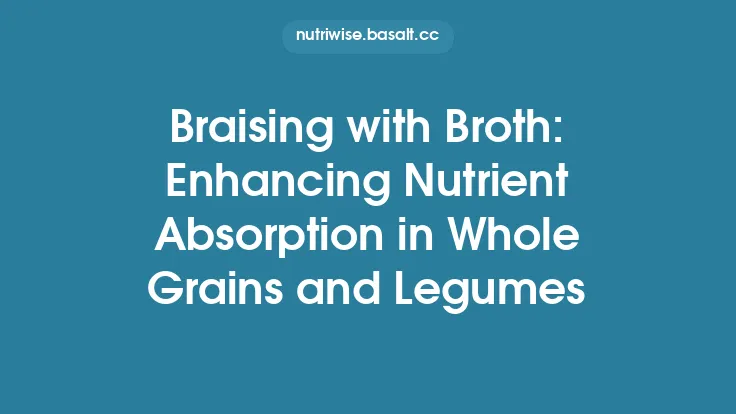The composition of a food’s matrix is not a static property; it fluctuates throughout the year in response to climate, plant developmental stage, animal husbandry cycles, and post‑harvest handling. These seasonal shifts alter the physical architecture, chemical milieu, and micro‑structural barriers that nutrients must traverse before they become bioaccessible and ultimately absorbed. Understanding how the matrix evolves with the seasons provides a powerful lens for interpreting variations in nutrient uptake that are often observed in epidemiological studies and clinical nutrition trials, yet remain poorly explained when the food is treated as a chemically invariant commodity.
1. Seasonal Drivers of Matrix Remodeling in Plant Foods
1.1 Climate‑Induced Structural Adjustments
Temperature, photoperiod, and precipitation patterns dictate the balance between cell expansion and wall reinforcement. In cooler, shorter‑day conditions (e.g., early spring), many temperate vegetables exhibit thinner primary cell walls and higher turgor pressure, resulting in a softer texture. Conversely, during hot, dry summer months, plants often thicken secondary walls, deposit additional lignin, and accumulate cuticular waxes to limit water loss. These structural changes directly affect the diffusion path length for digestive enzymes and the mechanical breakdown required during mastication.
1.2 Phenolic and Antioxidant Fluxes
Secondary metabolites such as flavonoids, anthocyanins, and hydroxycinnamic acids are synthesized in response to UV exposure and pathogen pressure. Summer‑grown berries, for instance, can contain up to three times more anthocyanins than those harvested in early autumn. While these compounds confer health benefits, they also bind to proteins and minerals, forming complexes that can impede enzymatic hydrolysis and mineral solubilization in the gastrointestinal lumen.
1.3 Starch Granule Morphology and Amylose/Amylopectin Ratio
Cereal grains and tubers display seasonal variation in starch architecture. Cooler growing conditions favor the formation of larger, more crystalline A‑type granules with higher amylose content, whereas warmer conditions promote B‑type granules with increased amylopectin branching. The crystalline order influences the susceptibility of starch to amylolytic enzymes; highly ordered amylose regions resist gelatinization, delaying glucose release and altering post‑prandial glycemic responses.
1.4 Lipid Composition Shifts
Leafy greens and oil‑seed crops modulate their fatty acid profiles seasonally. In winter, higher proportions of saturated fatty acids (e.g., palmitic acid) are incorporated into membrane lipids to maintain fluidity at low temperatures. Summer leaves often accumulate polyunsaturated fatty acids (PUFAs) such as linoleic and α‑linolenic acids. Since lipids can act as carriers for fat‑soluble vitamins, these seasonal lipid changes affect the micellar solubilization step that precedes intestinal absorption of vitamins A, D, E, and K.
2. Seasonal Variations in Animal‑Derived Food Matrices
2.1 Intramuscular Fat and Marbling Patterns
Livestock grazing on pasture experience marked changes in diet composition across the grazing season. Spring grass, rich in chlorophyll and β‑carotene, leads to higher concentrations of carotenoid‑derived pigments and a more unsaturated intramuscular fat profile. In contrast, winter feedlots relying on conserved forages and grain supplements increase saturated fat deposition. The degree of marbling influences the physical dispersion of lipids during digestion, thereby modulating the formation of mixed micelles that solubilize lipophilic nutrients.
2.2 Milk Fat Globule Membrane (MFGM) Dynamics
Dairy cows produce milk with a seasonal rhythm in MFGM composition. Summer milk often contains elevated levels of phosphatidylcholine and sphingomyelin, reflecting the higher intake of fresh pasture rich in phospholipids. These membrane constituents affect the stability of milk fat globules during gastric lipolysis, which in turn influences the release of fat‑soluble vitamins and the bioavailability of bioactive milk peptides.
2.3 Egg Yolk Lipid and Protein Matrix
Free‑range hens that consume a diet varying with season (e.g., insects in spring, seeds in autumn) deposit differing amounts of omega‑3 fatty acids and carotenoids into the yolk. The yolk’s protein matrix, primarily vitellogenin, undergoes conformational changes in response to these lipid alterations, affecting the emulsification properties of the yolk during digestion and consequently the absorption efficiency of associated nutrients.
3. Mechanistic Pathways Linking Seasonal Matrix Changes to Nutrient Absorption
3.1 Mechanical Disintegration and Particle Size Distribution
The initial breakdown of food in the oral cavity and stomach is heavily dependent on matrix rigidity. Softer, less lignified matrices (typical of early‑season produce) generate finer particle sizes upon mastication, increasing the surface area exposed to digestive enzymes. Finer particles accelerate the rate of hydrolysis for carbohydrates and proteins, leading to earlier and higher peaks of glucose and amino acids in the bloodstream.
3.2 Enzyme Accessibility and Inhibition
Phenolic compounds that accumulate during high‑UV periods can form non‑covalent complexes with digestive enzymes such as α‑amylase and pepsin, reducing catalytic efficiency. Moreover, phenolics may chelate metal ions (e.g., Fe²⁺, Zn²⁺) required as cofactors for enzyme activity, indirectly diminishing nutrient breakdown. Seasonal spikes in these inhibitors can therefore produce measurable reductions in nutrient bioaccessibility.
3.3 Micellar Solubilization of Lipophilic Nutrients
The formation of mixed micelles in the small intestine is contingent upon the availability of bile salts, phospholipids, and free fatty acids. Seasonal variations in dietary lipid saturation influence the critical micelle concentration (CMC) and the size of micelles. Unsaturated fatty acids, more prevalent in summer produce, lower the CMC, facilitating the incorporation of fat‑soluble vitamins into micelles and enhancing their absorption. Conversely, a higher proportion of saturated fats in winter may raise the CMC, potentially limiting micellar capacity.
3.4 Intestinal Transporter Regulation
Emerging evidence suggests that the expression of nutrient transporters (e.g., SGLT1 for glucose, PEPT1 for di‑ and tripeptides, NPC1L1 for cholesterol) can be modulated by dietary matrix components. Seasonal diets rich in certain fibers or phytochemicals may up‑ or down‑regulate these transporters via signaling pathways involving peroxisome proliferator‑activated receptors (PPARs) and nuclear factor‑κB (NF‑κB). While the precise temporal dynamics remain under investigation, the concept underscores a feedback loop where matrix composition influences the absorptive machinery.
4. Analytical Approaches to Quantify Seasonal Matrix Variability
4.1 Microscopy and Image Analysis
Scanning electron microscopy (SEM) and confocal laser scanning microscopy (CLSM) provide high‑resolution visualization of cell wall thickness, starch granule morphology, and lipid droplet distribution. Seasonal samples can be compared quantitatively using image‑based metrics such as mean wall thickness, granule aspect ratio, and lipid droplet size distribution.
4.2 Spectroscopic Fingerprinting
Fourier‑transform infrared (FT‑IR) spectroscopy and Raman spectroscopy enable rapid profiling of biochemical constituents (e.g., cellulose, lignin, lipids, proteins). Multivariate analysis of spectral data can detect subtle shifts in functional group composition that correspond to seasonal changes.
4.3 Chromatographic and Mass Spectrometric Techniques
High‑performance liquid chromatography (HPLC) coupled with diode‑array detection or mass spectrometry (MS) is essential for quantifying phenolic profiles, fatty acid composition, and vitamin content across seasons. Gas chromatography‑MS (GC‑MS) is particularly valuable for detailed fatty acid methyl ester (FAME) analysis in animal tissues.
4.4 In Vitro Digestion Models
Standardized static or dynamic gastrointestinal simulators (e.g., INFOGEST protocol) can be employed to assess how seasonal matrix alterations affect the release of nutrients during digestion. By measuring the soluble fraction after simulated gastric and intestinal phases, researchers can infer changes in bioaccessibility attributable to matrix variation.
5. Nutritional Implications and Practical Considerations
5.1 Seasonal Planning for Nutrient Adequacy
Dietitians and nutrition planners can leverage knowledge of matrix seasonality to recommend food selections that align with specific nutrient goals. For example, individuals seeking higher bioavailable iron may benefit from consuming early‑season leafy greens, which typically possess lower phenolic inhibition and more readily digestible cell walls than their late‑season counterparts.
5.2 Tailoring Supplementation Strategies
When seasonal foods are limited (e.g., during winter months in high‑latitude regions), targeted supplementation of nutrients that are known to be less bioaccessible due to matrix changes can mitigate potential deficiencies. However, supplementation should be calibrated to avoid excess, especially for fat‑soluble vitamins whose absorption may already be compromised by a more saturated dietary lipid profile.
5.3 Food Storage and Minimal Processing to Preserve Seasonal Traits
Post‑harvest handling can either preserve or erode the seasonal matrix characteristics. Rapid cooling, controlled atmosphere storage, and minimal mechanical handling help retain cell wall integrity and phenolic content. Conversely, aggressive washing or mechanical shredding can artificially alter the matrix, confounding the natural seasonal effects.
5.4 Implications for Public Health Nutrition Policies
Seasonal variability in nutrient absorption underscores the importance of promoting diverse, locally sourced produce throughout the year. Public health campaigns that encourage consumption of seasonally appropriate foods can improve overall nutrient status at the population level, reducing reliance on fortified foods and supplements.
6. Future Research Directions
- Longitudinal Cohort Studies – Tracking individuals’ nutrient status across multiple seasons while documenting detailed dietary matrix characteristics would clarify the real‑world impact of seasonal matrix changes on health outcomes.
- Omics Integration – Combining metabolomics, proteomics, and transcriptomics of both food matrices and intestinal tissues can elucidate the molecular mechanisms by which seasonal components modulate transporter expression and enzyme activity.
- Personalized Nutrition Algorithms – Incorporating seasonal matrix data into predictive models could enable personalized dietary recommendations that optimize nutrient absorption based on an individual’s metabolic phenotype and the time of year.
- Climate Change Projections – As global temperature patterns shift, the traditional seasonal signatures of many crops are expected to change. Modeling how these alterations will affect matrix composition and nutrient bioavailability is critical for future food security planning.
7. Concluding Perspective
Seasonal fluctuations are an intrinsic dimension of the food matrix, shaping the physical barriers, chemical interactions, and micro‑environmental cues that govern nutrient release and intestinal uptake. By moving beyond the static view of foods as immutable nutrient packages, researchers and practitioners can appreciate how the timing of harvest, the prevailing climate, and the natural growth cycle collectively dictate the efficiency with which our bodies access the nutrients embedded within. Harnessing this insight enables more nuanced dietary guidance, supports the design of food systems that preserve beneficial matrix attributes, and ultimately contributes to a more resilient and health‑optimizing food supply.





